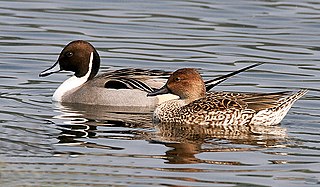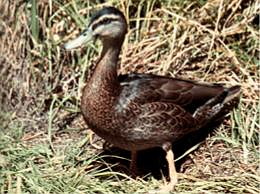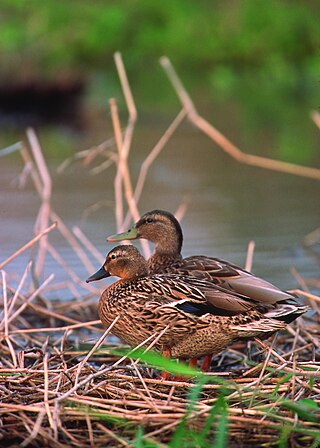
Fowl are birds belonging to one of two biological orders, namely the gamefowl or landfowl (Galliformes) and the waterfowl (Anseriformes). Anatomical and molecular similarities suggest these two groups are close evolutionary relatives; together, they form the fowl clade which is scientifically known as Galloanserae or Galloanseres. This clade is also supported by morphological and DNA sequence data as well as retrotransposon presence/absence data.

The Anatinae are a subfamily of the family Anatidae. Its surviving members are the dabbling ducks, which feed mainly at the surface rather than by diving. The other members of the Anatinae are the extinct moa-nalo, a young but highly apomorphic lineage derived from the dabbling ducks.

The pintail or northern pintail is a duck species with wide geographic distribution that breeds in the northern areas of Europe and across the Palearctic and North America. It is migratory and winters south of its breeding range to the equator. Unusually for a bird with such a large range, it has no geographical subspecies if the possibly conspecific duck Eaton's pintail is considered to be a separate species.

The northern shoveler, known simply in Britain as the shoveler, is a common and widespread duck. It breeds in northern areas of Europe and across the Palearctic and across most of North America, wintering in southern Europe, the Indian subcontinent, Southeast Asia, Central America, the Caribbean, and northern South America. It is a rare vagrant to Australia. In North America, it breeds along the southern edge of Hudson Bay and west of this body of water, and as far south as the Great Lakes west to Colorado, Nevada, and Oregon.

The gadwall is a common and widespread dabbling duck in the family Anatidae.

The mallard or wild duck is a dabbling duck that breeds throughout the temperate and subtropical Americas, Eurasia, and North Africa. It has been introduced to New Zealand, Australia, Peru, Brazil, Uruguay, Argentina, Chile, Colombia, the Falkland Islands, and South Africa. Belonging to the subfamily Anatinae of the waterfowl family Anatidae, mallards live in wetlands, eat water plants and small animals, and are social animals preferring to congregate in groups or flocks of varying sizes.

The green-winged teal or American teal is a common and widespread duck that breeds in the northern areas of North America except on the Aleutian Islands. It was considered conspecific with the Eurasian teal for some time, but the two have since been split into separate species. The American Ornithological Society continues to debate this determination; however, nearly all other authorities consider it distinct based on behavioral, morphological, and molecular evidence. The scientific name is from Latin Anas, "duck" and carolinensis, "of Carolina".

The American black duck is a large dabbling duck in the family Anatidae. It was described by William Brewster in 1902. It is the heaviest species in the genus Anas, weighing 720–1,640 g (1.59–3.62 lb) on average and measuring 54–59 cm (21–23 in) in length with an 88–95 cm (35–37 in) wingspan. It somewhat resembles the female and eclipse male mallard in coloration, but has a darker plumage. The male and female are generally similar in appearance, but the male's bill is yellow while the female's is dull green with dark marks on the upper mandible. It is native to eastern North America. During the breeding season, it is usually found in coastal and freshwater wetlands from Saskatchewan to the Atlantic in Canada and the Great Lakes and the Adirondacks in the United States. It is a partially migratory species, mostly wintering in the east-central United States, especially in coastal areas.

The yellow-billed duck is a 51–58 cm long dabbling duck which is an abundant resident breeder in southern and eastern Africa. This duck is not migratory, but wanders in the dry season to find suitable waters. It is highly gregarious outside the breeding season and forms large flocks.

The Indian spot-billed duck is a species of large dabbling duck that is a non-migratory breeding duck throughout freshwater wetlands in the Indian subcontinent. The name is derived from the red spot at the base of the bill that is found in the mainland Indian population. When in water it can be recognized from a long distance by the white tertials that form a stripe on the side, and in flight it is distinguished by the green speculum with a broad white band at the base. This species and the eastern spot-billed duck were formerly considered conspecific, together called the spot-billed duck.

The Laysan duck, also known as the Laysan teal, is a dabbling duck endemic to the Hawaiian Islands. Fossil evidence reveals that Laysan ducks once lived across the entire archipelago, but today survive only on Laysan Island and two atolls. The duck has several physical and behavioral traits linked to the absence of ground-based predators in its habitat. By 1860, the ducks had disappeared from everywhere except Laysan Island. The introduction of European rabbits by guano miners at the end of the 19th century brought the bird to the brink of extinction in 1912, with twelve surviving individuals. Rabbits were eradicated from the island in 1923 and numbers of Laysan ducks began to rise, reaching 500 by the 1950s. In an effort to ensure the long-term future of this duck, 42 birds were translocated to Midway Atoll National Wildlife Refuge in 2002. These thrived in their new surroundings, and another group were later relocated to Kure Atoll.

The mottled duck or mottled mallard is a medium-sized species of dabbling duck. It is intermediate in appearance between the female mallard and the American black duck. It is closely related to those species, and is sometimes erroneously considered a subspecies of the former.

The falcated duck or falcated teal is a gadwall-sized dabbling duck from the east Palearctic.

The Pacific black duck is a dabbling duck found in much of Indonesia, New Guinea, Australia, New Zealand, and many islands in the southwestern Pacific, reaching to the Caroline Islands in the north and French Polynesia in the east. It is usually called the grey duck in New Zealand, where it is also known by its Maori name, pārera.

The red-billed teal or red-billed duck is a dabbling duck which is an abundant resident breeder in southern and eastern Africa typically south of 10° S. This duck is not migratory, but will fly great distances to find suitable waters. It is highly gregarious outside the breeding season and forms large flocks.

Meller's duck is a species of the dabbling duck genus Anas. It is endemic to eastern Madagascar. Although a population was established on Mauritius in the mid-18th century, this is on the verge of extinction due to habitat loss and competition by feral domestic ducks. The species name of this species is after the botanist Charles James Meller, and its generic name is from the Latin for "duck".

The Mariana mallard or Oustalet's duck is an extinct species of duck of the genus Anas that was endemic to the Mariana Islands. Its taxonomic status is debated, and it has variously been treated as a full species, a subspecies of the mallard or of the Pacific black duck, or sometimes as a subspecies of the Indian spot-billed duck.

The Hawaiian duck or koloa is a species of bird in the family Anatidae that is endemic to the large islands of Hawaiʻi. Taxonomically, the koloa is closely allied with the mallard. It differs in that it is monochromatic and non-migratory. As with many duck species in the genus Anas, Hawaiian duck and mallards can interbreed and produce viable offspring, and the koloa has previously been considered an island subspecies of the mallard. However, all major authorities now consider this form to be a distinct species within the mallard complex. Recent analyses indicate that this is a distinct species that arose through ancient hybridization between mallard and the Laysan duck. The native Hawaiian name for this duck is koloa maoli, or simply koloa. This species is listed as endangered by the IUCN Red List of Threatened Species, and its population trend is decreasing.

The eastern spot-billed duck or Chinese spot-billed duck is a species of dabbling duck that breeds in East and Southeast Asia. This species was formerly considered a subspecies of the Indian spot-billed duck and both were referred to as the spot-billed duck. The name is derived from the yellow spot on the bill.

The Mallard complex refers to closely linked members of the Anas genus found around the world thought to all be descended from one common ancestor. Species in the mallard complex are known for frequent hybridization amongst other members of the complex. The species within the complex can be very difficult to distinguish genetically, likely due to either hybridization, the retention of ancestral genetic variation or both. The phenotypes of mallard complex ducks, particularly the "mallardine" species can be difficult to distinguish due to hybridization, backcrossing and the possible retention of ancestral genetic variation giving species a trait they would not usually have. The American black duck, for instance may have double white bars above and below the speculum due to either the retention of ancestral genetic material or due to gene flow from the Mallard.






















